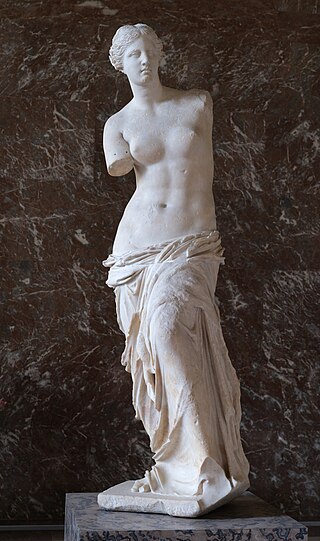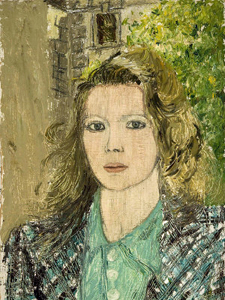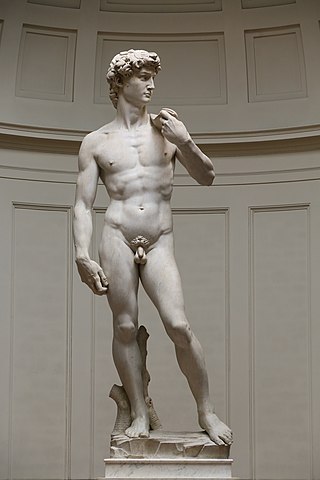
Erotic art is a broad field of the visual arts that includes any artistic work intended to evoke arousal. It usually depicts human nudity or sexual activity, and has included works in various visual mediums, including drawings, engravings, films, paintings, photographs, and sculptures. Some of the earliest known works of art include erotic themes, which have recurred with varying prominence in different societies throughout history. However, it has also been widely considered taboo, with either social norms or laws restricting its creation, distribution, and possession. This is particularly the case when it is deemed pornographic, immoral, or obscene.

Alice Neel was an American visual artist. Recognized for her paintings of friends, family, lovers, poets, artists, and strangers, Neel is considered one of the greatest American portraitists of the 20th century. Her career spanned from the 1920s to 1980s.
Jennifer Anne Saville is a contemporary British painter and an original member of the Young British Artists. Saville works and lives in Oxford, England and she is known for her large-scale painted depictions of nude women. Saville has been credited with originating a new and challenging method of painting the female nude and reinventing figure painting for contemporary art. Some paintings are of small dimensions, while other are of much larger scale. Monumental subjects come from pathology textbooks that she has studied that informed her on injury to bruise, burns, and deformity. John Gray commented: "As I see it, Jenny Saville's work expresses a parallel project of reclaiming the body from personality. Saville worked with many models who under went cosmetic surgery to reshape a portion of their body. In doing that, she captures "marks of personality for the flesh" and together embraces how we can be the writers of our own lives."

Carolee Schneemann was an American visual experimental artist, known for her multi-media works on the body, narrative, sexuality and gender. She received a B.A. in poetry and philosophy from Bard College and a Master of Fine Arts from the University of Illinois. Originally a painter in the Abstract Expressionist tradition, Schneeman was uninterested in the masculine heroism of New York painters of the time and turned to performance-based work, primarily characterized by research into visual traditions, taboos, and the body of the individual in relation to social bodies. Although renowned for her work in performance and other media, Schneemann began her career as a painter, saying: "I'm a painter. I'm still a painter and I will die a painter. Everything that I have developed has to do with extending visual principles off the canvas." Her works have been shown at the Los Angeles Museum of Contemporary Art, the Museum of Modern Art in New York, the London National Film Theatre, and many other venues.

Depictions of nudity include all of the representations or portrayals of the unclothed human body in visual media. In a picture-making civilization, pictorial conventions continually reaffirm what is natural in human appearance, which is part of socialization. In Western societies, the contexts for depictions of nudity include information, art and pornography. Information includes both science and education. Any ambiguous image not easily fitting into one of these categories may be misinterpreted, leading to disputes. The most contentious disputes are between fine art and erotic images, which define the legal distinction of which images are permitted or prohibited.

Sylvia Sleigh was a Welsh-born naturalised American realist painter who lived and worked in New York City. She is known for her role in the feminist art movement and especially for reversing traditional gender roles in her paintings of nude men, often using conventional female poses from historical paintings by male artists like Diego Vélazquez, Titian, and Jean-Auguste-Dominique Ingres. Her most well-known subjects were art critics, feminist artists, and her husband, Lawrence Alloway.

Feminist art is a category of art associated with the feminist movement of the late 1960s and 1970s. Feminist art highlights the societal and political differences women experience in their lives. The goal of this art form is to bring a positive and understanding change to the world, leading to equality or liberation. Media used range from traditional art forms, such as painting, to more unorthodox methods such as performance art, conceptual art, body art, craftivism, video, film, and fiber art. Feminist art has served as an innovative driving force toward expanding the definition of art by incorporating new media and a new perspective.

The nude, as a form of visual art that focuses on the unclothed human figure, is an enduring tradition in Western art. It was a preoccupation of Ancient Greek art, and after a semi-dormant period in the Middle Ages returned to a central position with the Renaissance. Unclothed figures often also play a part in other types of art, such as history painting, including allegorical and religious art, portraiture, or the decorative arts. From prehistory to the earliest civilizations, nude female figures were generally understood to be symbols of fertility or well-being.

Miriam Schapiro was a Canadian-born artist based in the United States. She was a painter, sculptor, printmaker, and a pioneer of feminist art. She was also considered a leader of the Pattern and Decoration art movement. Schapiro's artwork blurs the line between fine art and craft. She incorporated craft elements into her paintings due to their association with women and femininity. Schapiro's work touches on the issue of feminism and art: especially in the aspect of feminism in relation to abstract art. Schapiro honed in her domesticated craft work and was able to create work that stood amongst the rest of the high art. These works represent Schapiro's identity as an artist working in the center of contemporary abstraction and simultaneously as a feminist being challenged to represent women's "consciousness" through imagery. She often used icons that are associated with women, such as hearts, floral decorations, geometric patterns, and the color pink. In the 1970s she made the hand fan, a typically small woman's object, heroic by painting it six feet by twelve feet. "The fan-shaped canvas, a powerful icon, gave Schapiro the opportunity to experiment … Out of this emerged a surface of textured coloristic complexity and opulence that formed the basis of her new personal style. The kimono, fans, houses, and hearts were the form into which she repeatedly poured her feelings and desires, her anxieties, and hopes".
Julie Rrap is an Australian contemporary artist who was raised on the Gold Coast in Queensland. She was born Julie Parr, and reversed her name to express her sense of opposition. Since the mid-1970's she has worked in photography, painting, sculpture, video and performance. Julie's work expresses her interest in images of the body, especially the female body.
Anita Slavin Arkin Steckel was an American feminist artist known for paintings and photomontages with sexual imagery. She was also the founder of the arts organization "The Fight Censorship Group", whose other members included Hannah Wilke, Louise Bourgeois, Judith Bernstein, Martha Edelheit, Eunice Golden, Juanita McNeely, Barbara Nessim, Anne Sharpe and Joan Semmel.

Fine art nude photography is a genre of fine-art photography which depicts the nude human body with an emphasis on form, composition, emotional content, and other aesthetic qualities. The nude has been a prominent subject of photography since its invention, and played an important role in establishing photography as a fine art medium. The distinction between fine art photography and other subgenres is not absolute, but there are certain defining characteristics.
Aleah Chapin is an American painter whose direct portrayals of the human form have expanded the conversation around western culture’s representations of the body in art. Described by Eric Fischl as “the best and most disturbing painter of flesh alive today,” Chapin’s work has explored aging, gender and beauty, influenced in part by the community within which she was raised on an island in the Pacific Northwest. More recently, Chapin's work has taken a radically inward shift, expanding her visual language in order to better express the turbulent times we are living in. Consistent throughout her career, Chapin’s work asks the question: What does it mean to exist within a body today?
Martha Nilsson Edelheit, also known as Martha Ross Edelheit, is an American-born artist currently living in Sweden. She is known for her feminist art of the 1960s and 1970s, which focuses on erotic nudes.
Holly Trostle Brigham is an American figurative painter whose feminist self-portraiture focuses on female subjects drawn from mythology and history.
Juanita McNeely was an American feminist artist known for her bold works that illustrate the female experience in her nude figurative paintings, prints, paper cut-outs, and ceramic pieces. Feminist emotional elements in her work include the portrayal of female experiences such as abortion, rape, and menstruation. Her recurring health problems and expressive figurative compositions have prompted comparisons to Frida Kahlo. According to McNeely, "we as women must continue the struggle to hold on to our rights, or let the children lead the way."
Eunice Golden is an American feminist painter from New York City, known for exploring sexuality using the male nude. Her work has been shown at the Whitney Museum of American Art, Brooklyn Museum, Bronx Museum of the Arts, Westbeth Gallery, and SOHO20 Gallery.
Frances Borzello is a British art historian and scholar, feminist art critic and author. Her work specializes in the social history of art, and includes study on the social position of European woman artists in the context of their society, the study of female self-portraits and female nudes. She authored the book Seeing Ourselves: Women's Self Portraits, which has been continuously published since 1998 and has 30 editions. Her work widely recognized as contribution to the fields of art history and women's studies.
Clarity Haynes is a queer feminist American artist and writer. She currently lives and works in New York, NY. Haynes is best known for her unconventional painted portraits of torsos, focusing on queer, trans, cis female and nonbinary bodies. She is a former member of the tART Collective and the Corpus VI Collective.

The Oval Court is an artwork created between 1984 and 1986 by British artist Helen Chadwick. The work was part of Chadwick's first major solo exhibition entitled Of Mutability, held at the Institute of Contemporary Arts in London. Chadwick received a Turner Prize nomination in 1987 for the exhibition, making her one of the first women nominated for the prize. The work is currently in the collection of the Victoria and Albert Museum in South Kensington, London.










